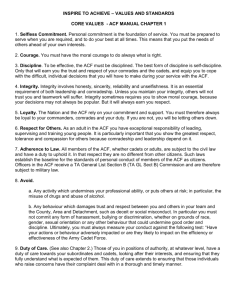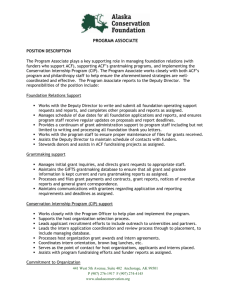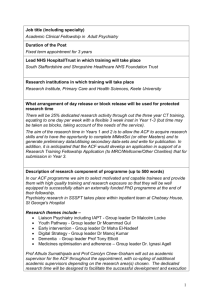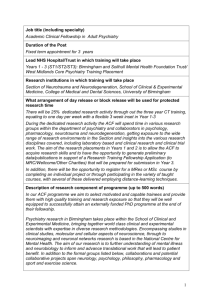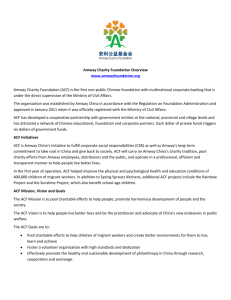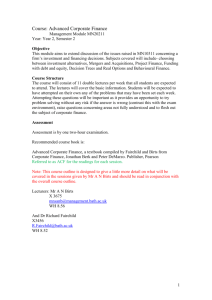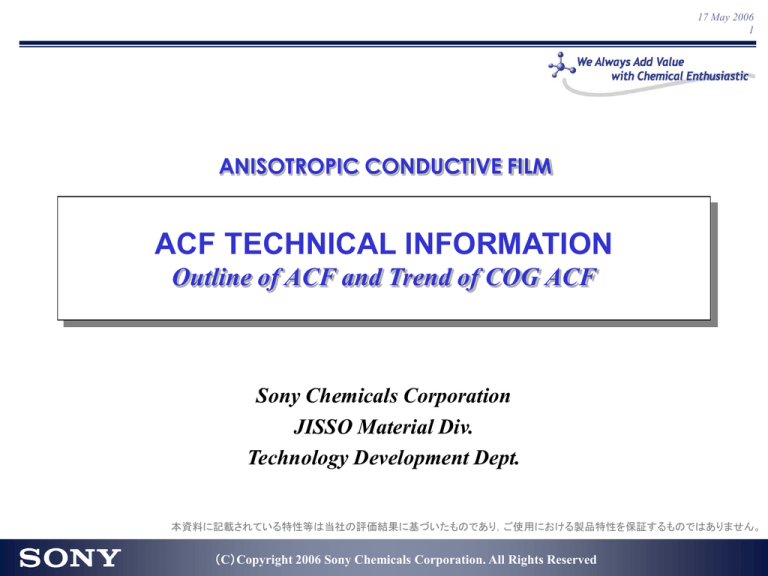
17 May 2006
1
ANISOTROPIC CONDUCTIVE FILM
ACF TECHNICAL INFORMATION
Outline of ACF and Trend of COG ACF
Sony Chemicals Corporation
JISSO Material Div.
Technology Development Dept.
本資料に記載されている特性等は当社の評価結果に基づいたものであり,ご使用における製品特性を保証するものではありません。
(C)Copyright 2006 Sony Chemicals Corporation. All Rights Reserved
Table of Contents
1. Outline of ACF
Conductivity, Insulation, Adhesion and Reaction
etc..
2. Trend of COG ACF
Road Map, COG Trend for Fine Pitch
ACF technology for fine pitch
Development map of COG ACF
etc..
(C)Copyright 2006 Sony Chemicals Corporation. All Rights Reserved
17 May 2006
2
1. Outline of ACF
1) Outline of ACF
Structure and Function of ACF
2) Basic Functions of ACF
Conductivity
Achievement of Conductivity
Control of particle capture
Particle Deformation
Effect of cushion material
Insulation
Insulator Coating Particles
Insulated Particle and Short
Adhesion, Reaction
Reaction Rate and Interfacial Adhesion, Cohesion
ACF Curing Process
Reaction of ACF
Ref.) Measuring method of reaction rate /FT-IR, DSC
Elastic Modulus and Tg
(C)Copyright 2006 Sony Chemicals Corporation. All Rights Reserved
17 May 2006
3
17 May 2006
4
Structure of ACF
ACF: Anisotropic Conductive Film
Conductive material is dispersed in the adhesive film.
Conductive Particle
Binder (Thermoset resin)
Ex. Epoxy resin
(Insulator Coating)
Au
Ni
Resin
Φ3~5μm
Ex. Metal plated resin particle
Conductive Particles
(C)Copyright 2006 Sony Chemicals Corporation. All Rights Reserved
17 May 2006
5
ACF Process Outline
Coating
Dry
Laminate
Dryer
Step1: Material mixing
Step2: Coating
Check Appearance
Slitter
Step3: Slitting
Step4: Rewinding & Check
(C)Copyright 2006 Sony Chemicals Corporation. All Rights Reserved
Step5: Packing
17 May 2006
6
Structure of ACF / Product Form
Surface Treatment
Cover film (Transparent, t=12, 25μm)
Double Type
ACF
Surface Treatment
Base film
(White or Translucent, t=38, 50, 75μm)
Single Type
ACF
Base film
(White or Translucent, t=38, 50, 75μm)
Surface Treatment
(C)Copyright 2006 Sony Chemicals Corporation. All Rights Reserved
Function of ACF and Parameter of ACF bonding
17 May 2006
7
Basic Functions of ACF
ACF is a functional adhesive tape which is able to connect
(conductivity, adhesion, insulation) multi-terminals in one time.
Conductivity
Step-1
ACF selection to match bonding materials
Step-2
Decision to optimize bonding condition
Insulation
Adhesion
Temperature, Pressure, Time
Parameter of ACF Bonding
Glass
(Panel)
Chip
ACF
(C)Copyright 2006 Sony Chemicals Corporation. All Rights Reserved
17 May 2006
8
Examples of ACF application
COG: Chip on Glass
FOG: Flex on Glass
COF: Chip on Flex
FOF: Flex on Flex
(replacement of connector,FPC-C/D)
(C)Copyright 2006 Sony Chemicals Corporation. All Rights Reserved
17 May 2006
9
Comparison between COG and FOG ACF
ACF for FOG
Item
Conductivity
○: Minimum Contact Area
13um×0.8mm=10400um2
◎: Minimum Contact Area
13um×100um=1300um2
Finepitch
Insulation
○: Minimum Conductor Space 20μm
◎: Minimum Conductor Space 12μm
Finepitch
Adhesion
◎:FPC/Panel,
compatibility for all FPC type
○:IC/Panel
Corrosion proof
○
◎:High Reliability
Low Temp.
Short Time
◎:Short Tact,Productivity up
○: Warpage Stress
Required
Characteristics
ACF Structure
ACF Features
ACF for COG
Single Layer
2 layer (ACF/NCF)
Particle
4~10μm / Ni/Au coated Resin particle
3~4μm/ Ni/Au coated Resin particle
Insulated Particle
No (Partly Coated)
Insulator coated
Particle density
Low:~0.5million/mm3
High:~6million/mm3(ACF layer)
Cured ACF Hardness
Relatively soft:Tg=less than 130℃
Relatively hard:Tg=around 140~170℃
(C)Copyright 2006 Sony Chemicals Corporation. All Rights Reserved
17 May 2006
10
Basic Functions of ACF
- Particle Deformation
- Particle Capture
Conductivity
- Cohesion
- Insulator coated particle
- Particle Diameter / Density
Reaction
Insulation
- Interfacial adhesion
Adhesion
(C)Copyright 2006 Sony Chemicals Corporation. All Rights Reserved
Basic Functions of ACF /Conductivity
- Particle Deformation
- Particle Capture
Conductivity
1) Sufficient particles capture on a bump ⇒ Particle capture
Reaction
More than 3 particles are required.
Statistics method is applied like ave.-3σ.
Insulation
Adhesion
2) Sufficient particle deformation
⇒ Bonding pressure
Pay attention to Tool co-planarity, Bump Height deviation,
Bump deformation (Short)
(C)Copyright 2006 Sony Chemicals Corporation. All Rights Reserved
17 May 2006
11
17 May 2006
12
Achievement of Conductivity
Plastic Core
Conductivity
Bump
Ni/Au Plating
Conductive Particle
ITO
Glass
Pressure Conductivity shall be obtained through Ni/Au plating layer
on a surface of particle.
(C)Copyright 2006 Sony Chemicals Corporation. All Rights Reserved
Roles of Conductive Particle
17 May 2006
13
Particles absorb deviation of
bump and trace height
Particles keep the conductivity by their
restitution when stress is applied
High margin for bump and
High Reliability
trace height deviation
(C)Copyright 2006 Sony Chemicals Corporation. All Rights Reserved
17 May 2006
14
Minimum particle Capture
<TEG>
ACF:CP88-series
Glass:ITO-glass
< Bonding Condition> 190℃40MPa-5s
<Reliability condition> 85℃85%RH 1000h
- 85℃85%RH-1000h -
100
100
90
90
Conductive resistance [Ω]
Conductive resistance [Ω]
- 初期値 80
70
60
50
40
30
20
open
good
80
70
60
excellent
50
40
30
20
10
10
0
0
0
1
2
3
4
5
6
7
8
9
10 11 12 13 14 15
0
1
Number of conductive particles [pcs./bump]
2
3
4
5
6
7
8
9
10 11 12 13 14 15
Number of conductive particles [pcs./bump]
・ Conductivity is achieved in 1 particle on a bump.
For consideration of reliability, more than 3 particle on a bump is required.
・ More than 5 particles on a bump achieves stable conductivity in reliability.
(C)Copyright 2006 Sony Chemicals Corporation. All Rights Reserved
Control of particle capture (normal distribution and standard deviation σ)
17 May 2006
15
Excellent particle capture performance to apply 4.5σ control.
Normal Distribution
Particle capture usually follows normal distribution.
50
45
実測値 n=240
40
正規分布曲線
Probability
Probability less
than Ave.-xσ
Frequency
35
30
25
20
15
10
Ave.-xσ
5
0
0
5
10
15
20
25
30
Numbers of conductive particles [pcs./bump]
Ave.-4.5σAve.-3σ
Ave.-3σ
Ave.-4.5σ
Ave.
Particle Capture on a bump(pcs.)
Probability MORE THAN
Ave. – x σ
Probability LESS THAN
Ave. – x σ
0.99865
1350ppm (0.00135)
0.9999966
3.4ppm (0.0000034)
The values above table are the probability of only lower side.
(C)Copyright 2006 Sony Chemicals Corporation. All Rights Reserved
17 May 2006
16
Particle Deformation
20MPa
40MPa
60MPa
100MPa
Pressure
Too weak
Good
(C)Copyright 2006 Sony Chemicals Corporation. All Rights Reserved
Too strong
17 May 2006
17
Particle Deformation and Conductive Resistance
Bump
Deformed Bump ⇒ Bump Short
Particle
ITO
Glass
6 MPa
Maximum Conductive resistance
after 1000h[Ω]
Pressure:
40 MPa
100 MPa
60
50
40
30
20
10
Aging 85℃85%R.H.
0
0
20
40
60
80
100
120
Bonding Pressure [MPa]
Relationship between particle deformation and conductivity in reliability test
(C)Copyright 2006 Sony Chemicals Corporation. All Rights Reserved
17 May 2006
18
Effect of cushion material
<ACF>
ACF for Fine Pitch(4μm Particle)
Teflon
<Bonding Condition>
190℃-40MPa-5sec
Head is tilted on purpose when bonding
Heat
Tool
TEG-Glass
TEG-IC
ACF
Stage
<Teflon>
None,50μm,80μm,100μm
Bump-B
Bump-A
<Bump/Particle Deformation>
Teflon
None
50μm
80μm ※
100μm ※
Bump-A
Bump-B
※:attention to temperature profile (next page)
(C)Copyright 2006 Sony Chemicals Corporation. All Rights Reserved
17 May 2006
19
Effect of Cushion Material
<ACF>
ACF for Fine Pitch(4μm Particle)
<Bonding Condition>
190℃-40MPa-5sec
Head is tilted on purpose when bonding
<Teflon>
None,50μm,80μm,100μm
< Temperature Profile >
< Initial Conductive Resistance >
None
50μmT
80μmT
100μmT
Conductive resistance(Ω)
50
190℃
Ave.
Max.
40
30
20
10
5s
5s
5s
5s
0
None
50μm
80μm
100μm
Teflon thickness
To use cushion material,
・ Tool co-planarity tilt is released and particle deformation and conductive resistance is improved
・ However, temperature rise time becomes slow
⇒ Pay attention to reaction rate down
(C)Copyright 2006 Sony Chemicals Corporation. All Rights Reserved
Basic Functions of ACF /Insulation
17 May 2006
20
1) To use insulated particle
2) To use small particle
Conductivity
3) To decrease particle quantity
- Insulator coated particle
(disadvantage to minute bump application)
- Particle Diameter / Density
Insulated particle prevents short.
Reaction
Insulation
As particle quantity is able to increase,
Adhesion
apply for minute bump (Fine Pitch)
(C)Copyright 2006 Sony Chemicals Corporation. All Rights Reserved
17 May 2006
21
Insulator Coating Particles
Insulator coating
Normal
Insulated
Particle
Particle
Ni/Au-Plating
IC
Bump
Glass
Short circuit occurs when the particles
are jammed between bumps.
Insulation is kept when the particles
are jammed between bumps.
(C)Copyright 2006 Sony Chemicals Corporation. All Rights Reserved
17 May 2006
22
Insulated Particle and Short
Bump Space
Bump
ACF
: CP60-series
Bump Space :15,12.5,10μm
Bump Height :15μm
Bonding Condition: 190℃-80MPa-5s
N=16set (10point/set)
Number of Short
Pattern
16
3um Insulated particle
14
4um particle
4um Insulated particle
12
4μm Particle
10
8
4μm Insulated particle
6
4
2
0
10um
12.5um
15um
3μm Insulated particle
Bump Space
・ Small diameter particle is able to apply narrow space.
・ Insulated particle realizes more narrow space.
(C)Copyright 2006 Sony Chemicals Corporation. All Rights Reserved
Basic Functions of ACF /Adhesion, Reaction
17 May 2006
23
Conductivity
- Cohesion
Reaction
Insulation
- Interfacial adhesion
Adhesion
(C)Copyright 2006 Sony Chemicals Corporation. All Rights Reserved
Reaction Rate and Interfacial Adhesion, Cohesion
17 May 2006
24
1. Adhesion (interfacial adhesion) becomes higher to raise reaction rate.
LSI
ACF
Pattern
Interfacial adhesion between ACF
and adhered material
Substrate
Material and surface condition (shape・contamination) influences on the adhesion.
(Especially, Attention to type of FPC and contamination on glass)
2. ACF cohesion (hardness) becomes higher and conductive resistance
becomes good to raise reaction rate.
hold the particles repulsion
Cohesion (≒Hardness)
(C)Copyright 2006 Sony Chemicals Corporation. All Rights Reserved
17 May 2006
25
Reaction Rate and Adhesion /FOG
ACF:Developed ACF for FOG
TEG:2 layer FPC(CA-type), ITO-Glass
Bonding condition: 140~200℃,3MPa,5~10sec
Method:Y-peel, 50mm/min
10.0
Peel Strength [N/cm]
9.0
8.0
7.0
Good Adhesion
6.0
5.0
4.0
3.0
2.0
1.0
0.0
0
20
40
60
80
100
Reaction rate [%]
Cure the ACF sufficiently (Sufficient reaction rate)
(C)Copyright 2006 Sony Chemicals Corporation. All Rights Reserved
17 May 2006
26
Reaction Rate and Conductivity /FOG
ACF:Developed ACF for FOG
TEG:2layer FPC(CA-type), ITO-Glass
Bonding condition: 140~200℃,3MPa,5~10sec
Conductive resistance [Ω]
60.0
ave
max
50.0
40.0
30.0
20.0
Good Conductivity
10.0
0.0
0
20
40
60
80
Reaction rate [%]
(C)Copyright 2006 Sony Chemicals Corporation. All Rights Reserved
100
Cohesion of ACF
Reactivity
Cohesion
(Hardness)
Degree of curing ?
Reaction Rate (FT-IR)
Characteristics of Cured ACF
Hardness after curing ?
Elastic Modulus
Tg (Glass transition Temp.)
(C)Copyright 2006 Sony Chemicals Corporation. All Rights Reserved
17 May 2006
27
17 May 2006
28
Reaction of ACF
< Reaction of Epoxy resin >
Heat
Epoxy resin
O CH2
CH
CH2
O
+
O
Curing agents
Anion/Cation
CH
CH2
CH2
n
O
< Reference:Reaction of Acryl resin >
Heat
Acryl resin
CH
CH2
+
Curing agents
CH
CH2
Radical
(C)Copyright 2006 Sony Chemicals Corporation. All Rights Reserved
n
Evaluation Example of ACF reaction
17 May 2006
29
- FT-IR -
IR(Infrared Spectrometry)
Analysis for ACF hardening reaction by measuring decrease of functional group
Functional Group
Example of ACF
(Epoxy Group)
Hardening Reaction
CH2
CH ~
CA
CA
+ CH2
CH ~
Functional Group
O
O
(Epoxy Group)
Wave length
After bonding ACF
Equipment: BIORAD FTS165
After bonding, Epoxy group decrease.
Reaction Rate [%]
Initial ACF
CH
~
OH
Absorption
Absorption
Wave length
CH2
100
90
80
70
60
50
40
30
20
10
0
145
155 165 175 185 195
Bonding Temperature [℃]
The peak height of Epoxy group also decrease.
(C)Copyright 2006 Sony Chemicals Corporation. All Rights Reserved
205
Relationship between Elastic Modulus, Tg and Conductive Resistance
17 May 2006
30
Tg:Glass Transition Temperature
<Ref:Tg of various Plastic>
Glass Region
Rubber Region
Silicone Rubber :-125℃
Teflon
:-110℃
PET
:67℃
poly vinyl acetate:28~30℃
(chewing gum)
Elastic Modulus
(Hardness)
Binder is hard and
Binder is soft and
conductive resistance keeps good
conductive resistance increase
Temperature
High Tg (Hard)≒ Good conductive resistance in Reliability
(C)Copyright 2006 Sony Chemicals Corporation. All Rights Reserved
Factors for Adhesion-1 : FPC Type
17 May 2006
31
The adhesion changes depending on the FPC type
Adhesion surface:PI,Pattern
Adhesion surface:ADH,Pattern
Adhesion
<
2layer FPC
3layer FPC
ACF selection to meet the FPC type
(C)Copyright 2006 Sony Chemicals Corporation. All Rights Reserved
17 May 2006
32
Factors for Adhesion-2 :Surface Condition
Surface Condition of 2layer FPC
Anchor Effect
Adhesion
Rough surface
<
Various Material
In case low adhesion happens in the specific FPC,
Please ask FPC maker and ACF maker
(C)Copyright 2006 Sony Chemicals Corporation. All Rights Reserved
17 May 2006
33
ACF function and parameters
Item
Conductivity Insulation Adhesion Reactivity
◎
Temp./ time
Bonding
process
Material
◎
Temperature profile
Reaction points
◎
△
-
-
Fulidity
◎
○
-
-
Melt viscosity
Reactivity
◎
-
◎
◎
Reaction rate
Hardness
◎
-
○
Particle
◎
◎
-
-
Particle Characteristics
Particle diameter
Bump size
◎
-
-
-
Particle capture
Bump space
-
◎
-
-
Bump space
Bump hardness
◎
△
-
-
Bump Hardness (HV)
Bump height deviation
○
-
-
-
Bump shape
Contamination
○
-
◎
-
Contact angle,Surface tension
IC
Panel
◎
Tool co-planality
Particle deformation
Bump deformation
Pressure
ACF
-
Control Points
Tg
(C)Copyright 2006 Sony Chemicals Corporation. All Rights Reserved
2. Trend of COG ACF
- Road Map of COG applications Development
COG Trend for Fine Pitch
- Mechanism of Bump short
- ACF structure and particle capture efficiency
Melt viscosity in 2 layer structure
ACF fluidity by ACF structure
Effect of 2 layer ACF (Efficiency of Particle capture)
- Application of Fine pitch COG ACF
Ref) ACF Particle Density
Development map of COG ACF
(C)Copyright 2006 Sony Chemicals Corporation. All Rights Reserved
17 May 2006
34
ACFの最新動向(COG/FOG)
17 May 2006
35
2. Chip on Glass Bonding
3. Flex on Glass
1) Roadmap
2) Fine Pitch用ACFの開発系統図
~CP69-seriesの特性紹介
3) 低反り用ACFの開発系統図
1) 開発Roadmap
Binder系統図
導電粒子とFine Pitch対応
Chip
FPC(2Layer/3Layer)
LCD-Panel(Glass)
ACF
ACF
(C)Copyright 2006 Sony Chemicals Corporation. All Rights Reserved
17 May 2006
36
2005.8 Revised
Road Map of COG applications Development
Item
Material Trend & ACF Technical Trend
Material trend of TFT
Bump pitch (zigzag)
Bump area
Bump space / height
Material trend of CSTN
Bump pitch (straight)
Bump area
Bump space / height
>=40μmP
35-30μmP
>=2500μm2
25μmP
20μmP
~2000μm2
>=30μm / 15-20μmT
15μmP
~1800μm2
25μm / 15μmT
20μm / 15μmT
15μm / 15μmT
>=45μmP
40μmP
>=2500μm2
35μmP
30μmP
~2000μm2
25μmP
~1700μm2
~1300μm2
>=20μm / 15-20μmT
15μm / 15μmT
13-14μm / 15μmT
12μm / ~12μmT
■ Trend of COG mounting for large panel
Notes
■ Trend of long IC size ■ Trend of thin panel
year
ACF technical trend
Conductive particle
Other technology
ACF MODEL
~2003
2004
2005
2006
2007
Insulated 5μm Particles
Insulated 4μm Particles
■ Low stress
■ High reactivity
■ High reliability
Insulated 3-3.5μm Particles
■ Thin ACF
■ CP8830IH ( for low temperature-short time bonding 190℃-5sec.)
■ CP8830IH4 ( for small bump, 4μm insulation particles )
■ CP6030ID ( 2-Layer ACF. 4μm insulation particles. 1800μm2 )
■ CP6330ID ( 2-Layer ACF, High Insulation characteristics )
■ CP6920F3 ( 2-Layer ACF. 3μm insulation particles. 1300μm2 )
(C)Copyright 2006 Sony Chemicals Corporation. All Rights Reserved
2008
17 May 2006
37
Comparison between CSTN and TFT
LCD Model
CSTN
Straight
Bump Space
TFT
Stagger
Bump Space
Bump Layout
IC
Minimum Conductor Space
Minimum Conductor Space
Insulation layer
Pitch / Bump space
25~40μm / 12~15μm
15~25μm / 15~25μm
Bump size
1300~2000μm
1800~2000μm
Pattern
ITO
Metal/ITO
Insulation layer
No
Coated
Panel
Severe
Bump Space
Not Severe
Bump Space
Short
Others
Minimum Conductor Space
Minimum Conductor Space
Corrosion
Severe
Not Severe
Appearance Check
Particle deformation
Particle trace(Akkon)
Binder
High spec.
(Corrosion・Insulation・Particle capture)
Standard spec.
(particle capture)
Particle
Insulator coat
for Particle trace(Akkon)
ACF
(C)Copyright 2006 Sony Chemicals Corporation. All Rights Reserved
COG Trend for Fine Pitch
Market Trend of COG
・ Minute Bump
・ Fine Pitch
(Decrease of Conductor Space)
Required Technical Factor
1. Increase particle capture on a bump
2. Keep insulation by fine pitch trend
(C)Copyright 2006 Sony Chemicals Corporation. All Rights Reserved
17 May 2006
38
17 May 2006
39
Mechanism of Bump short
Bump
Particle
First stage of bonding
Particles are blocked
Overpressure
A heat and pressure is applied from
the bonding tool, and the particles
flows between bumps.
Particles are blocked between bumps.
Overpressure deforms the bumps.
The insulation coat destroys and
short occurs.
The short risk rises by large particle
and high particle density.
Short occurs at this stage if there is
no insulation layer.
Fluidity (melt viscosity)
Particle diameter / Density
Thickness of ACF
Particle capture efficiency
(25μm⇒20~22μm)
Insulator coating
(Structure of layer)
(C)Copyright 2006 Sony Chemicals Corporation. All Rights Reserved
ACF structure and particle capture efficiency
17 May 2006
40
Single layer
ACF flows when bonding and particles are easy to join between bumps.
2 layer ACF(ACF/NCF)
NCF layer (no particles) is forced to flow and particles are placed in the panel side.
(C)Copyright 2006 Sony Chemicals Corporation. All Rights Reserved
17 May 2006
41
Melt viscosity in 2 layer structure
1.0E+07
ACF層
NCF層
溶融粘度(Pa・s)
1.0E+06
1.0E+05
ACF
1.0E+04
1.0E+03
:CP60-series
:HAAKE RS150
:20-180℃, 10℃/min
ACF
装置
測定温度
1.0E+02
1.0E+01
<image schematic>
1.0E+00
0
20
40
60
80
100
120
140
160
180
200
温度(℃)
NCF layer:design for low melt viscosity. = easy to flow when bonding.
ACF layer:design for high melt viscosity. = hard to flow when bonding.
(C)Copyright 2006 Sony Chemicals Corporation. All Rights Reserved
ACF fluidity by ACF structure
Single layer
ACF
structure
2 layer structure (ACF/NCF)
+ different melt viscosity
Fluidity
when
bonding
As a design concept, low particle flow is observed in 2 layer ACF.
(C)Copyright 2006 Sony Chemicals Corporation. All Rights Reserved
17 May 2006
42
Effect of 2 layer ACF (Efficiency of Particle capture)
50
2層+流動差:48k個/mm2
2層+流動差:31k個/mm2
2層:42k個/mm2
単層:59k個/mm2
45
平均粒子捕捉数 [個/Bump]
17 May 2006
43
40
35
30
25
<TEG>
20
IC
: 1.8mmx20mm, t= 0.5mm,
Au-plated bump, h=15μm
15
10
Pattern ITO
: 1737F, 10 Ω□, t =0.7mm glass
Measure
: measured 200-240bumps
5
0
0
500
1000
1500
2000
2500
3000
3500
4000
Bump面積 [μm2]
・ 2 layer ACF has higher particle capture efficiency than single layer ACF
・ Fluidity difference between 2 layers achieves higher particle capture.
(C)Copyright 2006 Sony Chemicals Corporation. All Rights Reserved
17 May 2006
44
Development map of COG ACF for fine pitch
Min. contact area
[μm2]
Insulated Particle
CP88 series
CP8830IH4
- COG Standard
- Tg=138℃
- 190℃5sec~
2Layers ACF
2500
CP65 series
CP6530ID
- High insulation characteristics
- Tg=134℃
- 180℃7sec~
CP63 series
CP6330HD
- High Particle Capture
- Tg=146℃
- 190℃5sec~
- CP88series 2Layer
- 190℃5sec~
2000
CP69 series
CP6920F
CP60 series
CP6030ID
- High reactivity
- High particle capture
- High reliability (Tg=169℃)
- 180℃5sec~
1500
3μm particle
CP63 series
CP6330SD3
CP69 series
CP6920F3
1000
~2002
2003
2004
(C)Copyright 2006 Sony Chemicals Corporation. All Rights Reserved
2005~
17 May 2006
45
COG-ACF for fine pitch
CP6920F
CP6920F3
CP6030ID
CP8830IH4(ref)
ACF
ACF
ACF
ACF
NCF
NCF
NCF
NCF
Thickness of ACF
20μm
20μm
24μm
25μm
Conductive Particle (Au/Ni plated resin)
Φ4μm
Insulated
Φ3μm Insulated
Φ4μm
Insulated
Φ4μm
Insulated
Temp.
Pressure
Time
60-80℃
0.3-1MPa
1-2sec
60-80℃
0.3-1MPa
1-2sec
70-80℃
0.3-1MPa
2sec
40-80℃
0.3-1MPa
1-2sec
Temp.
200℃ ~
200℃ ~
190 ℃ ~
190℃ ~
pressure
60-80MPa
60-80MPa
60-80MPa
40-80MPa
Time
5sec
5sec
5sec
5sec
Minimum contact area*
um2
1800
1300
1800
-
Minimum bump space
um
15
12
15
15
Elastic modulus
at 30℃
2.6 Gpa
2.6 Gpa
2.5 Gpa
1.7Gpa
146 ℃
146 ℃
169℃
138 ℃
ACF
Structure
Pre-Bonding Condition
*2
Main Bonding
Condition *2
Tg
*:Avg-4.5σ≧3 particle catching
数値は代表値であり保証値ではありません。
(C)Copyright 2006 Sony Chemicals Corporation. All Rights Reserved
17 May 2006
46
Particle Capture /CP69-series
ACF
CP6920F
CP6920F3
Avg-3σ≧5
1500um2
1100um2
Avg-4.5σ≧3
1800um2
1300um2
Captured Particle(ave.pcs.)
50
45
CP6920F
CP6920F3
40
Ref-H
35
30
25
20
15
10
5
0
500
1000
1500
2000
2500
3000
3500
Contact Area(um2)
(C)Copyright 2006 Sony Chemicals Corporation. All Rights Reserved
Conductive Resistance /CP69-series
IC : 1.8mmx20mm, t= 0.5mm
Bump 30μmx 85μm Au-plated bump h=15μm 50-55HV
Pattern ITO : 1737F, 10 Ω□, t=0.7mm glass
Bonding Condition :
CP6920F/F3: 200℃-80MPa-5sec
Ref-H: 210℃-80MPa-5sec
Aging Condition : 85℃85%RH-1000hrs
Conductive resistance after 85℃85%RH1000hrs [Ω]
40
35
Ave
Max
30
25
20
15
10
5
0
CP6920F
CP6920F3
Ref-H
(C)Copyright 2006 Sony Chemicals Corporation. All Rights Reserved
17 May 2006
47
17 May 2006
48
Insulation /CP69series
Bump Space
Bump
Bump Space:10,12.5,15um
Bump Height:15μm
Bonding Condition:CP6920F/F3 200℃-80MPa-5s
Ref-H
210℃-80MPa-5s
N=8set (10point/set)
Pattern
CP6920F
CP6920F3
Ref-H
8
Number of Short(pcs)
7
6
5
4
3
2
1
0
10um
12.5um
Bump Space
15um
EXCELLENT
Insulation Performance
(C)Copyright 2006 Sony Chemicals Corporation. All Rights Reserved
ACFの最新動向(COG/FOG)
17 May 2006
49
2. Chip on Glass Bonding
3. Flex on Glass
1) Roadmap
2) Fine Pitch用ACFの開発系統図
~CP69-seriesの特性紹介
3) 低反り用ACFの開発系統図
1) 開発Roadmap
Binder系統図
導電粒子とFine Pitch対応
Chip
FPC(2Layer/3Layer)
LCD-Panel(Glass)
ACF
ACF
(C)Copyright 2006 Sony Chemicals Corporation. All Rights Reserved
17 May 2006
50
2005.5 Revised
Road Map of COG-input applications Development
Bonding Temp.
ACF Technical Trend
for 2Layer-FPC
~ 200℃
for 3Layer-FPC
2Layer FPC standard
~ 190℃
for Co-Use
2Layer/3Layer FPC standard
U.D.; Under developing
CP97-series
CP92-series
Corrosion Proof
~ 180℃
High Adhesion
Lower Temp. and Short time Bonding
CP59-series
CP91-series
CP76-series
CP53-series
CP94-series
~ 170℃
CP75-series
CP71-series
CP96-series
CP12-series
High Speed Bonding
3Layer FPC standard
(U.D.)
~ 160℃
CP52-series
Epoxy Resin
Bonding Time
Notes
~ 15sec ~
■ High adhesion to FPC
Acryl resin
~ 10sec ~
■ apply to 2Layer FPC/3Layer FPC
~ 5sec ~
■ High reactivity
■ Acrylic Curing System
■ Corrosion proof
(C)Copyright 2006 Sony Chemicals Corporation. All Rights Reserved
17 May 2006
51
粒子種類・径と対応pitch
表中の数値は代表値であり保証値ではありません
対応最小pitch
[μm]
50
70
100
200
対応最小配線Space
[μm]
20
30
50
100
導電粒子種類
樹脂
金属
導電粒子径
[μm]
4~5
5
5
5
9
9
6
絶縁coating 処理比率
[%]
100(I)
25(F)
0
0
0
0
0
4~5μm全数絶縁
5μm25%絶縁
一般的に用いられている粒径とpitch
5μm
9μm
金属6μm
4μm絶縁粒子
5μm絶縁粒子
5μm樹脂粒子
9~10μm樹脂粒子
COG用ACFと同Levelの高絶縁性
(C)Copyright 2006 Sony Chemicals Corporation. All Rights Reserved
金属粒子
17 May 2006
52
Notes of FOG bonding
Bonding head
Good condition
Resist damp up flow of
particle
Cushion
Short circuit between patterns
Bent COF by cushion
material damp up flow
of particle
(C)Copyright 2006 Sony Chemicals Corporation. All Rights Reserved
17 May 2006
53
Global support
CDMC Shanghai
ADMK Seoul
Sales & Engineer
Sales & Engineer
Technical Support Lab.
Resident ACF engineer makes the
quick response possible.
SCC Suzhou Plant
After process
CCMT Taipei
Sales & Engineer
CDMH Hong-Kong
Sales
SCC KANUMA
Plant & Engineer
SCC Head Office Tokyo
Sales
Kansai Office Osaka
Sales
(C)Copyright 2006 Sony Chemicals Corporation. All Rights Reserved
17 May 2006
54
What analysis can be done by TSL
Temperature, Pressure, Time
Glass
Insulation
Conductivity
Adhesion
Chip
(Panel)
ACF
Is the general view of the bonding excellent?
Microscope, Stereo microscope
Isn't the problem in a reactive rate?
FT-IR
Is pressure enough?
Cross-section observation
Is the insulation between terminals enough?
Microscope, SEM
Digital multi meter
Is an electric connection taken?
Digital multi meter
How much is bonding strength?
Universal testing machine
Isn't the problem in the life of ACF?
DSC, Constant Temperature / Humidity Chamber
(C)Copyright 2006 Sony Chemicals Corporation. All Rights Reserved
17 May 2006
55
general view of the bonding
(C)Copyright 2006 Sony Chemicals Corporation. All Rights Reserved
Cross-section observation
17 May 2006
56
Microscope, SEM
Plastic
Core
Conductivity
Ni/Au
Plating
断面研磨機
SEM
(C)Copyright 2006 Sony Chemicals Corporation. All Rights Reserved
Bump
Conductive Particle
ITO
Glass
17 May 2006
57
FT-IR
FT-IR; Fourier transform - Infrared Spectrometry
反応率 [%]
100
90
80
70
60
50
40
30
20
Epoxy 10
group)
0
145 155
165
175
185
圧着温度 [℃]
(C)Copyright 2006 Sony Chemicals Corporation. All Rights Reserved
195
205
17 May 2006
58
Universal testing machine & Digital multi meter
Universal testing machine
Method 1 : Y direction
F
Method 2 : X direction
F
Digital multi meter
(C)Copyright 2006 Sony Chemicals Corporation. All Rights Reserved
17 May 2006
59
DSC
反応率 [%]
DSC: Differential Scanning Calorimetry,
100
90
80
70
60
50
40
30
20
10
0
145 155 165 175 185 195 205
圧着温度 [℃]
総発熱量
反応開始温度
(C)Copyright 2006 Sony Chemicals Corporation. All Rights Reserved
Bonding machine
Installation schedule by October, '06
(C)Copyright 2006 Sony Chemicals Corporation. All Rights Reserved
17 May 2006
60
17 May 2006
61
中国触摸屏网与液晶网(http://www.51touch.com)
您下载的该触摸屏/液晶屏技术文档来自于中国触摸屏网与液晶网 ( http://www.51touch.com/ )
What you are downloading are from China Touchscreen&LCD Site: ( http://www.51touch.com/ )
中国触摸屏网/液晶网四大版块:
•
•
•
•
触摸屏/液晶屏论坛:
http://bbs.51touch.com/
触摸屏/液晶屏供求商机: http://b2b.51touch.com/
招聘/找工作求职:
http://bbs.51touch.com/forum-12-1.html
触摸屏查询系统:
http://www.51touch.com/software/
• 微信公众号:
微信中扫描右侧二维码
1. 触摸屏网/液晶网论坛:中国触摸屏网与液晶网论坛是触控面板和液晶面板人讨论触摸屏/液晶屏技术,解决触摸
屏/液晶屏技术问题,发布触摸屏/液晶屏产品供求信息,了解触摸屏/液晶屏市场动态,触摸屏/液晶屏厂商招聘和找
工作求职的第一平台。
2. 触摸屏/液晶屏供求商机:免费发布触摸屏/液晶屏相关产品:触控面板、触摸屏材料、触摸屏设备、触摸屏一体
机、人机界面、大屏幕显示器、广告机、金融自助设备、薄膜开关、电子显示屏、液晶屏、液晶面板、液晶模组、
液晶设备、液晶材料等。
3. 招聘/找工作求职:触摸屏/液晶屏厂商招聘和触摸屏/液晶屏行业人才找工作求职,招聘/找工作效果好!
4. 触摸屏查询系统:触摸屏软件开发范围包括:政府部门触摸屏查询系统、博物馆纪念馆查询系统、触摸屏楼盘展
示、触摸屏导览系统、房地产酒店宾馆写字楼商场触摸屏软件、学校医院社区触摸屏软件、触摸屏虚拟现实技术的
推广与研究。
中国触摸屏网 —— 无“触”不在
(C)Copyright 2006 Sony Chemicals Corporation. All Rights Reserved

